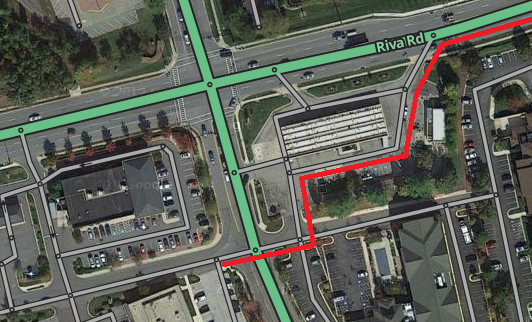Parking Lots
Mapping a parking lot road serves three purposes:
- it allows Waze to provide door-to-door directions within the lot;
- it allows the Waze client to get off the main road, avoiding erroneous traffic reports.
- it prevents the Waze client from routing thru-traffic along the parking lot segments.
For information pertaining to using the Parking Lot Place please see: Places/Parking lot.
The Parking Lot Road type exists to allow the mapping of parking lots, while discouraging the routing server from using them for through navigation. Waze applies a transition penalty when transitioning from a Parking Lot Road to another road type. This penalty decreases the chance that Waze will route through a parking lot as a shortcut but allows better navigation in and out of a parking lot. It is advised not to mix road types within a parking lot to avoid triggering the transition penalty unnecessarily.
Shopping Centers
When mapping a large parking lot (e.g., at a shopping center) consider mapping only the following:
- Main entrances from the roads outside the parking lot
- Lanes that run along storefronts
- Lanes that run along main roads outside the parking area (to prevent cars in the parking area from snapping to the main roads and sending incorrect speed information)
- Primary lanes that serve to get people from one area of the lot to another
Remember, the goals here are usability and simplicity. When in doubt, imagine yourself in a car in the lot at various points, and ask yourself what the most efficient way would be to get to a store at the other end of the lot, or to exit the lot and get back on a main road, with as few convolutions as possible. The lanes that are used the most in this thought experiment should be mapped, with the rest being omitted. You can turn on the GPS points layer (Shortcut key Shift-G) to see where traffic has been most recently to help determine what might be the best section to map.
In particular, do not map every single lane, and especially not every single parking space (it has been done!). This serves no purpose but to clutter the map, confuse directions, and put an unnecessary burden on both the client and server hardware. Remember usability and simplicity are #1. Your editing time and expertise can be better used elsewhere in the map.
Small Parking Lots
Parking lots that serve a small number of businesses should be minimal: enough to give the driver correct directions into and out of the lot, and navigate to a particular business. Very small lots with a single entrance/exit could even be represented by a single segment running diagonally across the parking area (lots with entrances on both sides) or a single, flattened curve (lots that only have entrances/exits along a single road, such as for strip malls).
Beware of Parking Lot exits that have a restricted turn (typically no left turn allowed across a median). Due to the way that Waze routing works in regards to penalties, if there is only one way out of a Parking Lot Waze may route you to take that restricted left turn. In these cases it would be better to provide another path out of the lot via an unrestricted turn.
Drive-Through Lots
Because these lots can be narrow and congested, with one-way sections, the simplest way to represent them may be as just a one-way drive-through loop. Caveat: because both ends of a segment cannot connect to the same junction, if the lot has only one entrance/exit, it is necessary to build the loop using three segments.
Parking Lots Separated By A Street
Be aware that when two parking lots are directly connected there is no routing penalty for routing through one from the other. Thus, there is no routing penalty to transition from one parking lot to another when the two parking lots are separated by a street and both share a junction node on the street. To be sure that Waze will apply the transition penalty when routing through one parking lot from another, the two parking lots must be isolated from the each other such that passing from one to the other requires driving over a road segment of a type that is not parking lot road or private road.
For example, in the configuration shown below if routing from the west parking lot, there is no transition penalty to route through the gas station parking lot on the east side of the street if routing east on Riva Rd. Conversely, if routing to the west parking lot from Riva Rd. there is no transition penalty to use the gas station.


This potential problem arises when two parking lots on opposite sides of a street connect at the same junction node on the street.

If this configuration causes routing problems it can be solved by changing the road type of one (or both) of the parking lot roads that intersect with the street.

A five meter or longer stub of a different road type will accomplish the same result.

If the street is a divided highway, then the road type of the crossover segment may be changed (this may also permit U-turns at the crossover segment).